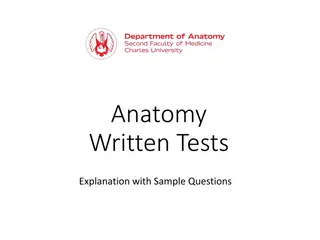Comprehensive Overview of Brain Imaging Techniques and Anatomy
Explore the world of brain imaging with functional MRI, MRI techniques, brain anatomy, neuronal activation, and brain vasculature explained in detail, shedding light on brain regions and their functions.
Download Presentation

Please find below an Image/Link to download the presentation.
The content on the website is provided AS IS for your information and personal use only. It may not be sold, licensed, or shared on other websites without obtaining consent from the author.If you encounter any issues during the download, it is possible that the publisher has removed the file from their server.
You are allowed to download the files provided on this website for personal or commercial use, subject to the condition that they are used lawfully. All files are the property of their respective owners.
The content on the website is provided AS IS for your information and personal use only. It may not be sold, licensed, or shared on other websites without obtaining consent from the author.
E N D
Presentation Transcript
Functional Magnetic Resonance Imaging (fMRI) Jan Petr Institute of Radiopharmaceutical Cancer Research
MRI quick summary Spin property of hydrogen atoms Using strong B0magnetic field 1.5 T, 3T clinical scanners 7T experimental scanners
MRI quick summary Imaging magnetic properties of tissue Proton density T1-weighted relaxation T2-weighted relaxation T2 PD T1
Brain imaging with different modalities PET (Positron emission tomography) Structure Soft tissue Bones Vessels Physiology Metabolism Function CT (Computed tomography) MRI
Functional MRI Image brain activity Spatial resolution ~mm Temporal resolution ~s
Brain regions Anatomical regions Individual difference size? shape? topology? Functional regions
Brain regions Examples of brain activation regions Sensory Motor Language Vision Touch Finger tapping Picture naming Listening to Reversing checkerboard words Passive active active passive passive
Brain anatomy Neurons and glial cells Neurons communicate through axons Through electrochemical processes
Brain anatomy Gray matter Consists mostly of neurons White matter Consists mostly of axons Gray matter White matter
Neuronal activation Integrative and signalling activity Change cell membrane potential Release of neurotrasmitters Ionic pumps to restore concentration gradients Requires glucose and oxygen
Brain vasculature Blood supplies brain with oxygen and glucose Internal carotid and vertebral arteries Further branching to microvessels and capillaries
Neurovascular coupling Neurovascular coupling Vasoactive substances Dilate vessels Reduces resistance Increase blood flow
fMRI physiology What is measured in fMRI? Electrical impulses? Neurotransmitters? Blood perfusion? Blood perfusion through the level of oxygenation
History of BOLD imaging BOLD Blood Oxygenation Level Dependent Ogawa et al., 1990 Mice and rats at 7T MRI Contrast on gradient-echo images influenced by proportion of oxygen in breathing gas Increasing oxygen content increased contrast Ogawa et al., 1992 Humans at 4T MRI Visual stimulation Changes of contrast in visual cortex
BOLD signal and T2* T2*relaxation decay of signal after excitation Two components of T2* : Intermolecular interactions dephasing T2signal decay Macroscopic magnetic field inhomogeneity dephasing T2 decay. 1 ?2 =1 +1 ?2 ?2
BOLD signal and T2* Why does blood oxygenation affect the BOLD MRI signal? Hemoglobin contains iron to bind the oxygen Oxyhemoglobin (oxHb) is diamagnetic Deoxyhemoglobin (dxHb) is paramagnetic Higher dxHb concentration increased magnetic susceptibility increased magnetic field inhomogeneities decrease T2* lower BOLD MRI signal
Hemodynamic response Neuronal activity Increased O2metabolism Increased dxHb lower BOLD signal? Neurovascular coupling Vessel dilation increased CBF dxHb concentration decreases higher BOLD signal
Hemodynamic response Brain function Metabolic rates Physiological effects Physical effects MR properties Neuronal activity Glucose and oxygen metabolism Cerebral blood volume (CBV) Magnetic field uniformity Decay Time (T2*) Cerebral blood flow (CBF) Blood oxygenation T2* weighted image intensity -+
Hemodynamic response Delay in BOLD signal change after activation Initial dip increase in oxygen consumption before CBF increase Undershoot CBF decrease faster than CBV Peak Rise Undershoot Baseline Peak Sustained response Rise Baseline Undershoot Initial dip
fMRI experimental design Goal: To detect what regions/voxels are active during a specific task
What sequence should be used for fMRI Neuronal response - 200-500ms Hemodynamic response ~s Standard whole brain sequence ~1mm spatial resolution Time resolution ~mins Fast single shot sequences Echo planar imaging (EPI) 500ms-2s acquisition
fMRI task design Detect brain signals associated with that state Create a desired cognitive state
Types of fMRI designs Block-design Detection power Event-related design More flexible Mixed design Block design Event-related design
Readout in fMRI design spatial resolution: time resolution coverage (number of slices) temporal resolution requires: spatial resolution coverage (number of slices) SNR (signal-to-noise ratio): Decreased spatial resolution Increased scan time via averaging Spatial resolution Temporal resolution SNR
fMRI study design BOLD signal combination CBV, CBF, CMRO2 Observe change of BOLD signal as a reaction on a task or event Stimulus HRF Expected response
I have my data, now what? Data pre-processing Structural MRI functional MRI
Why pre-process fMRI data Data are noisy (task-related change <5%) Subjects move Things change during the experiment Preprocessing: Increase signal to noise ratio Helps to meet assumptions for statistical analysis
Subject motion Correct for head motion 6 parameters rigid transformation 3 rotations 3 translations Lie very still Exclude subjects
Spatial normalization Register functional vs. anatomical per subject Register to average brain (MNI) Larger population Higher power > 6 DOF 6 DOF Between-subject Within-subject
Temporal filtering Temporal drift from scanner High-pass filter Physiological cycles (cardiac, respiratory)
Spatial filtering Convolution with a Gaussian kernel Improves SNR Specificity Reduces Spatial resolution Sensitivity
Is there an activation? A finger tapping example
A simple fMRI experiment Passive tapping vs rest (7 cycles) Blocks of 6 scans per cycle Is there a change in the BOLD response between finger tapping and rest? Stimulus function
A simple fMRI experiment Activation compare: Magnitude of response Measurement noise T-test Signal from one voxel Stimulus function Compare tap in green vs rest
General linear model Experimental data (Y) - linear combination ( ) of different model factors (x), along with uncorrelated noise ( ) Testing slope ( ) against null hypothesis 30 Y = x + 0+ 25 20 15 10 5 0 0 0 10 20 30 40
General linear model for fMRI Y = X * + timepoints Observed data (known) BOLD signal in a single voxel Design matrix (known) Error Model parameters (unknown) Contribution of each component of X to Y Difference between the observed data and model prediction Components that can explain the data
GLM example: Design Block design, language task Word generation (noun presented, verb generated) Word shadowing (verb presented, thinking on it) Rest Design matrix: generation shadowing rest
GLM example: Estimating betas Fitting model to data ordinary least squares minimizing ??? ? = ?? + ? ? = (???) 1??? 2 3 4 0 1 0 1 0 1 2 1 + 2 + 3
GLM example: Estimating betas Suboptimal fit ? = [0,0,3] 2 3 4 0 1 0 1 0 1 2 1 + 2 + 3 0 0 3
GLM example: Estimating betas Active in word generation ? = [0.83,0.16,2.98] 2 3 4 0 1 0 1 0 1 2 1 + 2 + 3 0.83 0.16 2.98
GLM example: Estimating betas Active in word generation and shadowing ?=[0.68, 0.82, 2.17] 1 2 3 0 1 0 1 0 1 2 1 + 2 + 3 0.68 0.82 2.17
GLM example: Estimating betas Voxel not active ?=[0.03, 0.06, 2.04] 1 2 3 0 1 0 1 0 1 2 1 + 2 + 3 0.03 0.06 2.04
GLM example: Voxelwise fit beta1 Calculate fit for every voxel beta2 0.83 0.16 2.98 beta3 ? = ? residuals ?2 ?2= 9.47 ?=1
GLM example: Significance Which of these series should we trust? Noise, effect size, number of measurements 1=1 =0.2 n=60 1=1 =0.5 n=60 1=1 =0.2 n=15 1=0.3 =0.2 n=60
GLM example: Contrast Weights c of model parameters c = [c1c2c3] for = [ 1 2 3] c = [1 0 0] Active in word generating c = [1 -1 0] More active in generating than in shadowing
GLM example: Hypothesis testing Null hypothesis (H0) there is no effect Alternative hypothesis (Ha) we find the effect in data Reject the null hypothesis activation 0.83 0.16 2.98 ??? = 1 = 0.83 0 0 ??? = 0 ??? 0 ?0: ??:
GLM example: t-contrast ??? ? = ? ??(???) 1? follows Student s distribution (N-1 degrees of freedom) Probability that the null hypothesis is true p-value <0.05 we reject the null hypothesis
GLM example: t-contrast example Voxels active in word generation c=[1 0 0]
GLM example: t-contrast example Voxel active more in generating than shadowing c=[1 -1 0]























